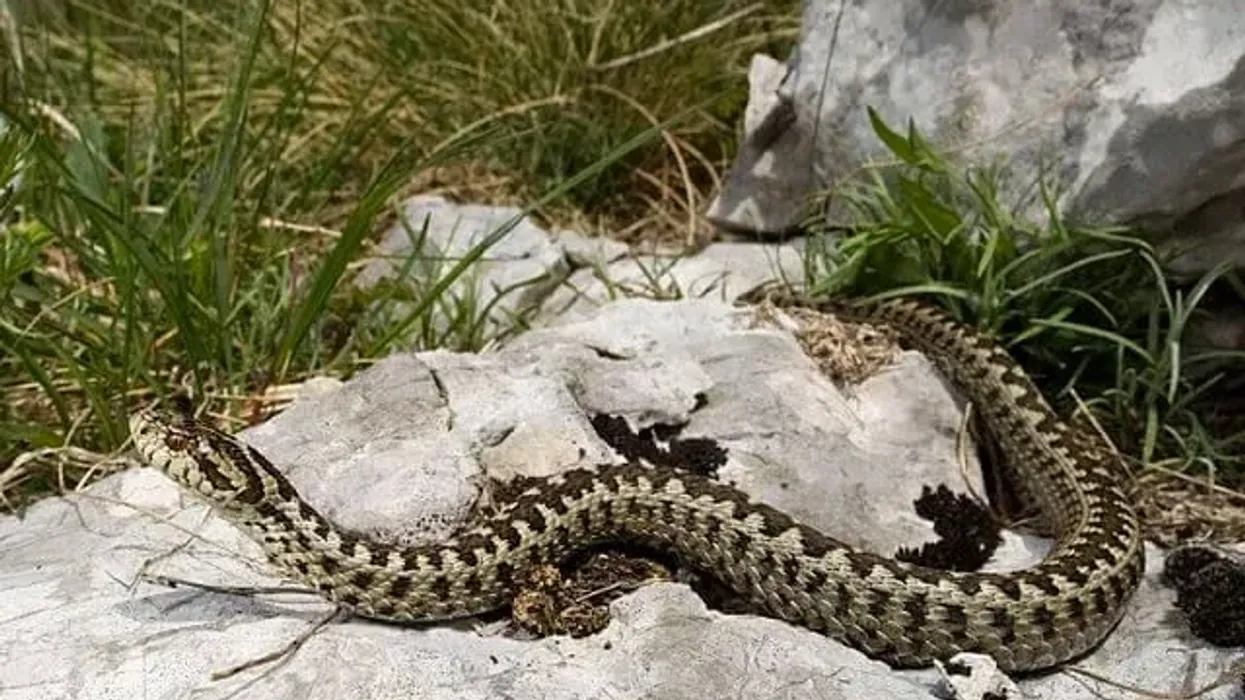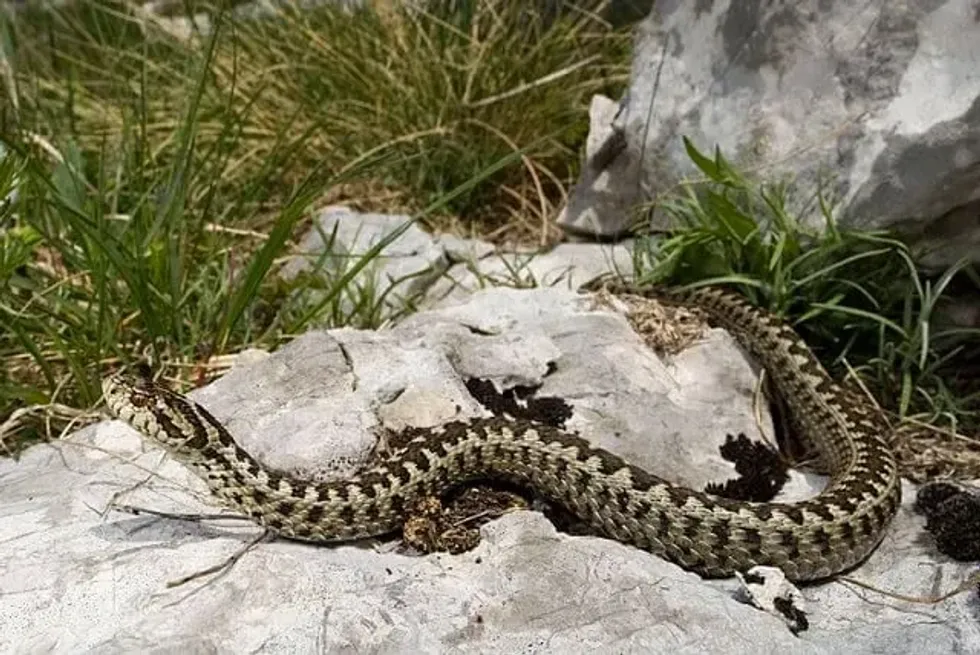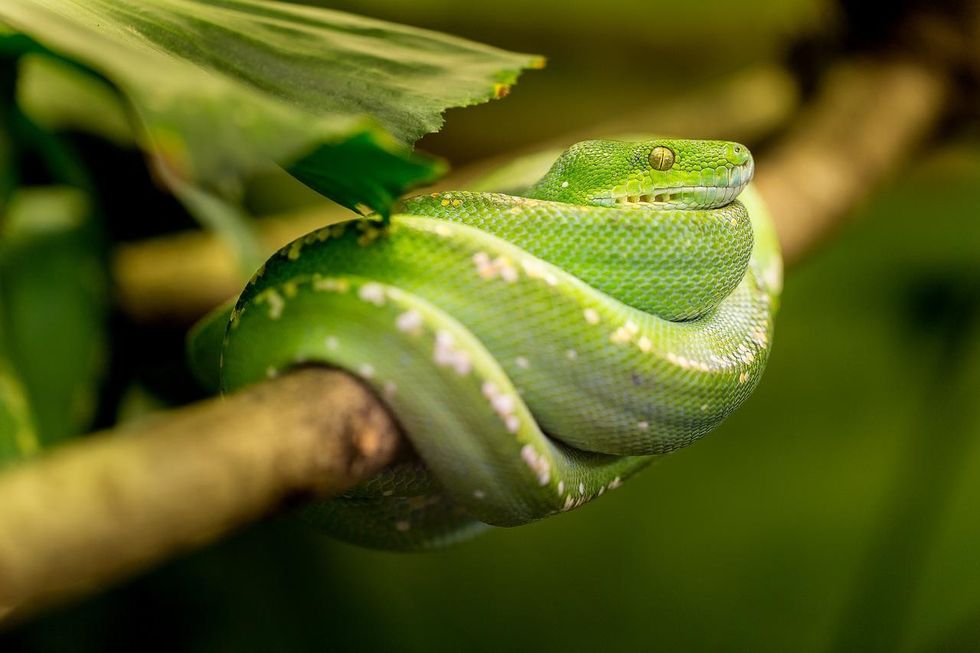The meadow viper (Vipera Ursinii) belongs to the family Viperidae. The population of this rare species is distributed across the range of France, Austria, Italy, Hungary, Montenegro, Albania, Romania, Bosnia and Herzegovina, Croatia, Greece, Bulgaria, Turkey, Armenia, Georgia, Russia, Azerbaijan, Kazakhstan, Uzbekistan, and Kyrgyzstan.
The habitat of this snake consists of meadows, steppes, dry slopes with pasturelands, rocky hillsides, and shrubs. It has been observed that breeding takes place around April and May.
After a gestation period of 90-120 days, a female snake gives birth is given to two to 22 live young ones.
Females are larger than males. The body of this snake is known to be thick, the head is narrow, and the snout is known to be upturned.
The appearance is known to be rough. These vipers are gray, tan, or yellowish in color and have an undulating, dark stripe, and are known to be edged or bordered with black.
The meadow viper diet consists of grasshoppers, locusts, spiders, crickets, small mammals, lizards, and birds. This snake is placed under the Vulnerable category of conservation status and thus, is protected.
The European part of the population is known to be highly threatened as compared to those found in China and Kazakhstan. These animals are threatened due to the loss of habitats and also climate change.
There are around seven subspecies of this viper that have been recognized. The Hungarian meadow viper (Vipera ursinii rakosiensis) is known to be one of the most Endangered subspecies.
It is really fascinating to learn about this snake and if you are interested, read our articles about anaconda snake and black racer3 for more snake facts.
Meadow Viper Interesting Facts
What type of animal is a meadow viper?
A meadow viper is a snake.
What class of animal does a meadow viper belong to?
It belongs to the class of Reptiles.
How many meadow vipers are there in the world?
There has been no specific count of the global population of meadow vipers recorded.
Where does a meadow viper live?
The population of this snake species is distributed across the range that includes France, Austria, Italy, Hungary, Montenegro, Albania, Romania, Bosnia and Herzegovina, Croatia, Greece, Bulgaria, Turkey, Armenia, Georgia, Russia, Azerbaijan, Kazakhstan, Uzbekistan, and Kyrgyzstan.
What is a meadow viper's habitat?
The habitat or ecology of this species consists of meadows, steppes, dry slopes with pasturelands, rocky hillsides, and shrubs.
Who do meadow vipers live with?
Meadow vipers are known to be generally solitary snakes or a solitary species and do not live in groups.
How long does a meadow viper live?
The exact lifespan of the meadow viper is unknown.
How do they reproduce?
The breeding season of this snake species is known to take place around April and May. Males are known to engage in fights for females.
The gestation period is around 90-120 days long and females are known to give birth to two to 22 live young. Sexual maturity is reached at almost three years of age. The male and female role in rearing the young ones is unknown.
What is their conservation status?
The meadow viper is placed under the Vulnerable category of conservation status.
Meadow Viper Fun Facts
What do meadow vipers look like?
Females tend to be larger than males. The body of this snake is thick, the head is narrow, and the snout is known to be upturned. The appearance is known to be rough.
There are several scales or plates on the head. The keeled dorsal scales are only in 19 rows and the dark skin shows between these scales. This species is known to be gray, tan, or yellowish in color and has an undulating, dark stripe, and is known to be bordered with black.

How cute are they?
These snakes are not considered cute.
How do they communicate?
Not a lot of information is available about the communication of these snakes but they are known to use tactile and chemical cues to communicate with each other.
How big is a meadow viper?
The length of this snake species 15.7-31.5 in (40-80 cm) and the meadow viper size is known to be larger than horned vipers and pit vipers.
How fast can a meadow viper move?
The exact speed of this snake species, meadow viper, is unknown but they are known to move quickly.
How much does a meadow viper weigh?
The weight of the meadow viper is unknown.
What are the male and female names of the species?
There are no specific names for a male and female of this species.
What would you call a baby meadow viper?
There is no particular name for a baby of this species but they are in general referred to as snakelets.
What do they eat?
This snake species of meadow vipers are known to be carnivores and their diet consists of grasshoppers, locusts, spiders, crickets, small mammals, lizards, and birds.
Are they poisonous?
This species is considered to be rare and mildly venomous.
Would they make a good pet?
Not much information is available about this snake species as pets.
Did you know...
The binomial name of this species, Ursinii, is kept in honor of Antonio Orsini, an Italian naturalist. It is also sometimes referred to as Orsini's viper and the population of these animals found in Italy is called an Italian meadow viper.
Around seven subspecies of this snake species have been identified, namely, Vipera ursinii ursinii, V. u. eriwanensis, V. u. graeca, V. u. macrops, V. u. moldavica, V. u. rakosiensis, V. u. renardi, and the common names of some of the subspecies are Italian meadow viper, karst viper or karst adder, Danubian meadow viper, Steppe viper or Steppe adder or Renard's viper, and Moldavian meadow viper.
The reason this animal is Endangered includes habitat destruction caused due to certain changes in agricultural practices and other human activities, and also climate change in their habitats.
The Hungarian meadow viper (Vipera ursinii rakosiensis) was recorded for the first time by Lajos Mehely in 1893, a Hungarian zoologist and it is believed that the total Hungarian population number is around 500 specimen or individuals.
The Hungarian meadow viper (Vipera ursinii rakosiensis) is also known as or referred to as the Danubian meadow viper and has been protected in Hungary since 1974.
These animals are diurnal which means they are most active during the day.
Adults are known to shed their skin almost thrice a year.
Is the meadow viper endangered?
The meadow viper is known to be a Vulnerable species and one of the major threats this species faces is habitat loss. This species is a strictly protected species in order to prevent it from going Extinct but not much information is available about the conservation measures.
The European population is more threatened than the ones in China and Kazakhstan.
What's the difference between a meadow viper and a tree viper?
Most tree vipers are known to be green and yellow in color with some bright markings, whereas, meadow vipers are tan, gray, or yellowish in color. Certain specific differences may be based on the various species and subspecies like the diet based on the range and habitat.
The meadow viper can be identified by its rough appearance and tan, gray or yellowish in color which are some of its unique features.
Here at Kidadl, we have carefully created lots of interesting family-friendly animal facts for everyone to discover! Learn more about some other reptiles from our scarlet snake facts and vine snake facts pages.
You can even occupy yourself at home by coloring in one of our free printable meadow viper coloring pages.









